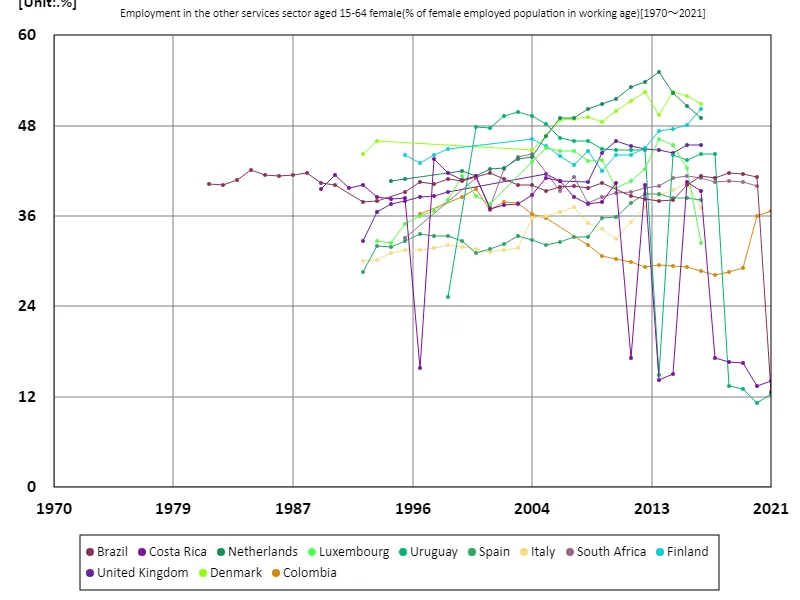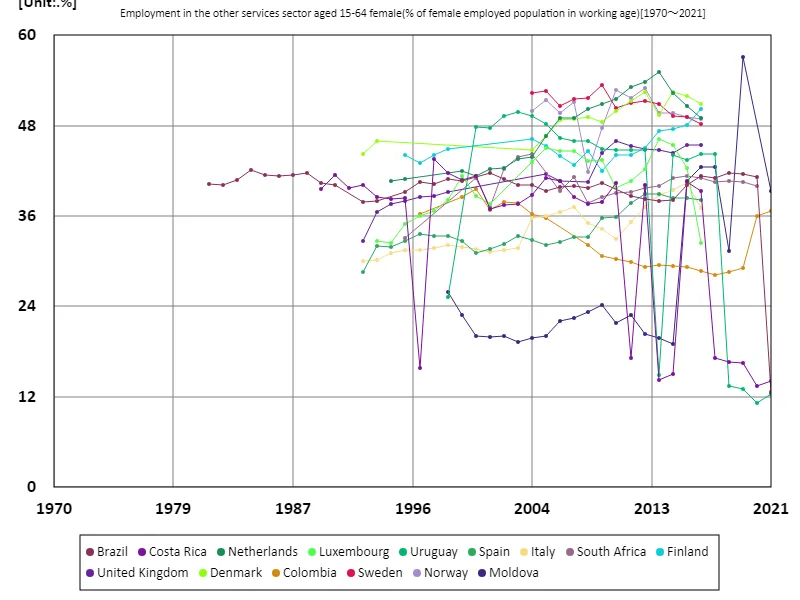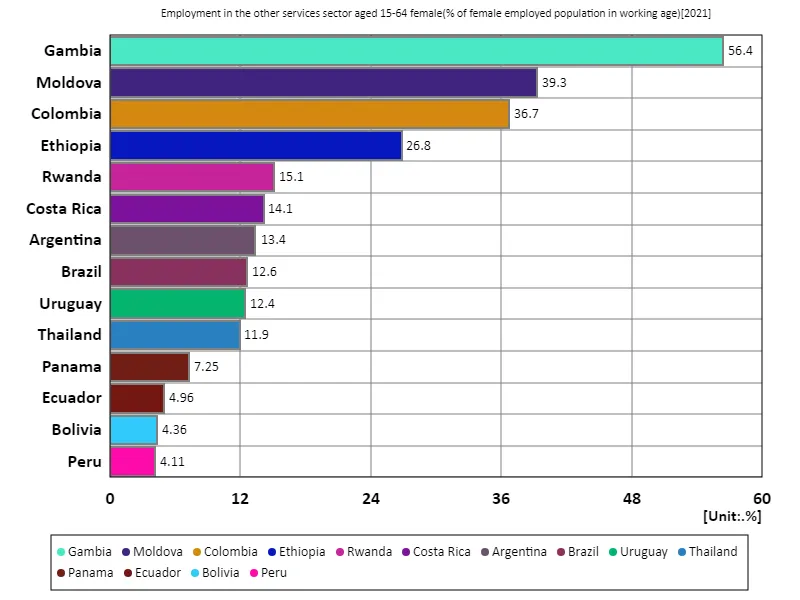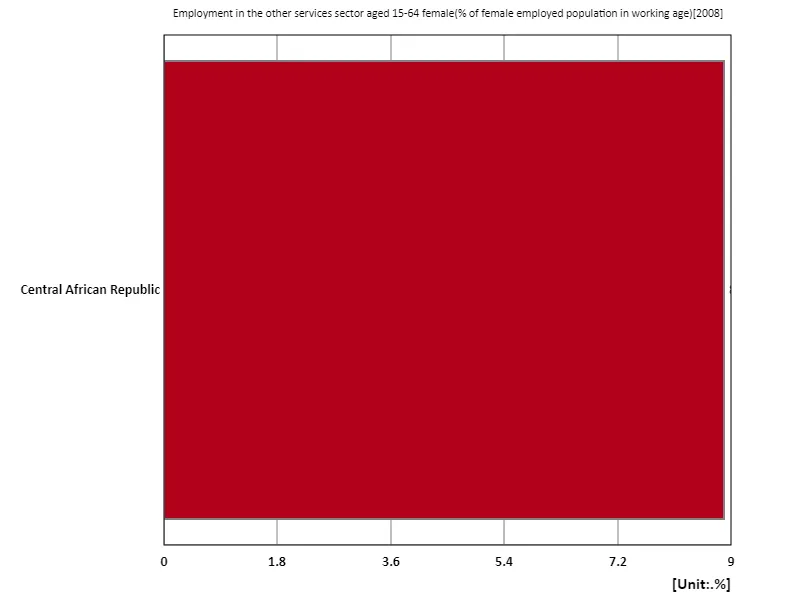- Abstract
- Employment rate for women aged 15-64 in other services sector (percentage of working-age female employment population)
- Employment rate for women aged 15-64 and other services (percentage of working-age female employment population) (Worldwide)
- Employment rate for women aged 15-64 in other services (percentage of working-age female employment population) (Worldwide, latest year)
- Employment rate for women aged 15-64 in other services (percentage of working-age female employment population) (region, latest year)
- Reference
Abstract
Uruguay’s other services sector employment rate of 6.52% in 2021 reflects differences in economic activity across regions and countries. The sector demonstrates the diversity and breadth of employment as it includes a wide range of services such as education, health care and public administration. Uruguay has a stable economy and a high standard of living, and its comprehensive public services are contributing to increased employment. Over the past few decades, service sector employment has been on the rise globally, especially in developed countries. This is due to the rise in knowledge-intensive jobs as the country shifts from manufacturing to services. Uruguay’s high employment rate suggests that the country recognizes the importance of its services sector and is strengthening related policies.
Employment rate for women aged 15-64 in other services sector (percentage of working-age female employment population)
Based on data from 1981 to 2021, employment rates for women aged 15-64 and in the other service sectors show widely varying trends across regions and countries. For example, the Netherlands recorded a high employment rate of 55.1% in 2013 and now stands at 88.8%. This is thought to be the result of policies that encourage women to participate in the labor market and the introduction of flexible working practices. On the other hand, countries like Colombia have a relatively high employment rate of 36.7% in 2021, which is influenced by their stage of economic development and social factors. Overall, many countries have increased female labor force participation over the past few decades, especially high-income countries. However, there are also regional differences and changes in employment rates due to labor market fluctuations, which are a complex mix of policy, economic environment, and socio-cultural factors.


The maximum is 55.1%[2013] of Netherlands, and the current value is about 88.8%
Employment rate for women aged 15-64 and other services (percentage of working-age female employment population) (Worldwide)
Between 1981 and 2021, there has been a notable change in employment rates for women ages 15-64 and other service sector workers. Moldova in particular recorded a high employment rate of 57.1% in 2019, which has since increased to 68.8%. This is likely the result of Moldova’s active promotion of women’s participation in the labor market. Meanwhile, in other countries, employment rates vary widely depending on the stage of economic development and different policies. High-income countries generally have higher female employment rates and often have better policies and childcare support, while employment rates have risen more slowly in low-income and developing countries. Overall, many countries have made efforts to increase female labor force participation in the past decades, but employment rates reflect regional variations and policy influences. The case of Moldova is an example of how economic and social reforms can contribute to women’s employment.


The maximum is 57.1%[2019] of Moldova, and the current value is about 68.8%
Employment rate for women aged 15-64 in other services (percentage of working-age female employment population) (Worldwide, latest year)
According to 2021 data, Gambia recorded the highest employment rate in the ”other service sector” for women aged 15-64 at 56.4%. This figure indicates that female labour market participation in the country is relatively strong. Meanwhile, the global average employment rate is 18.5%, making Gambia’s figure significantly higher. This reflects disparities in employment opportunities based on region and economic situation. The overall total of 259% also suggests multiple employment opportunities and flexibility in the labour market, which may result in women working multiple jobs. In high-income countries, more women work full-time or part-time in the ”other service sector”, while in low-income countries employment rates tend to be lower. Over the past few decades, many countries have made efforts to increase female labor force participation, but local economic and social factors still have a significant impact on employment rates. Such data will help policymakers develop specific strategies to improve the labor market.


The maximum is 56.4% of Gambia, the average is 18.5%, and the total is 259%
Employment rate for women aged 15-64 in other services (percentage of working-age female employment population) (region, latest year)
According to 2008 data, the Central African Republic has the highest employment rate in the ”other service sector” for women aged 15-64 at 8.89%, while the overall average and total are also 8.89%. This figure highlights that female employment in the ”other services sector” is very low globally, particularly in low-income and developing countries. The Central African Republic’s high employment rate is relative and, although high compared to other countries, the figure itself remains very low. This low employment rate may be due to economic structure, educational opportunities, lack of vocational training, or cultural factors. Overall, the 2008 data shows that women have limited work opportunities in the ”other service sector.” This is likely due to the stage of economic development, social barriers and labor market inequalities. The data also highlights that while many countries are taking steps to improve employment opportunities for women, significant challenges remain, particularly in low-income countries.


The maximum is 8.89% of Central African Republic, the average is 8.89%, and the total is 8.89%



Comments